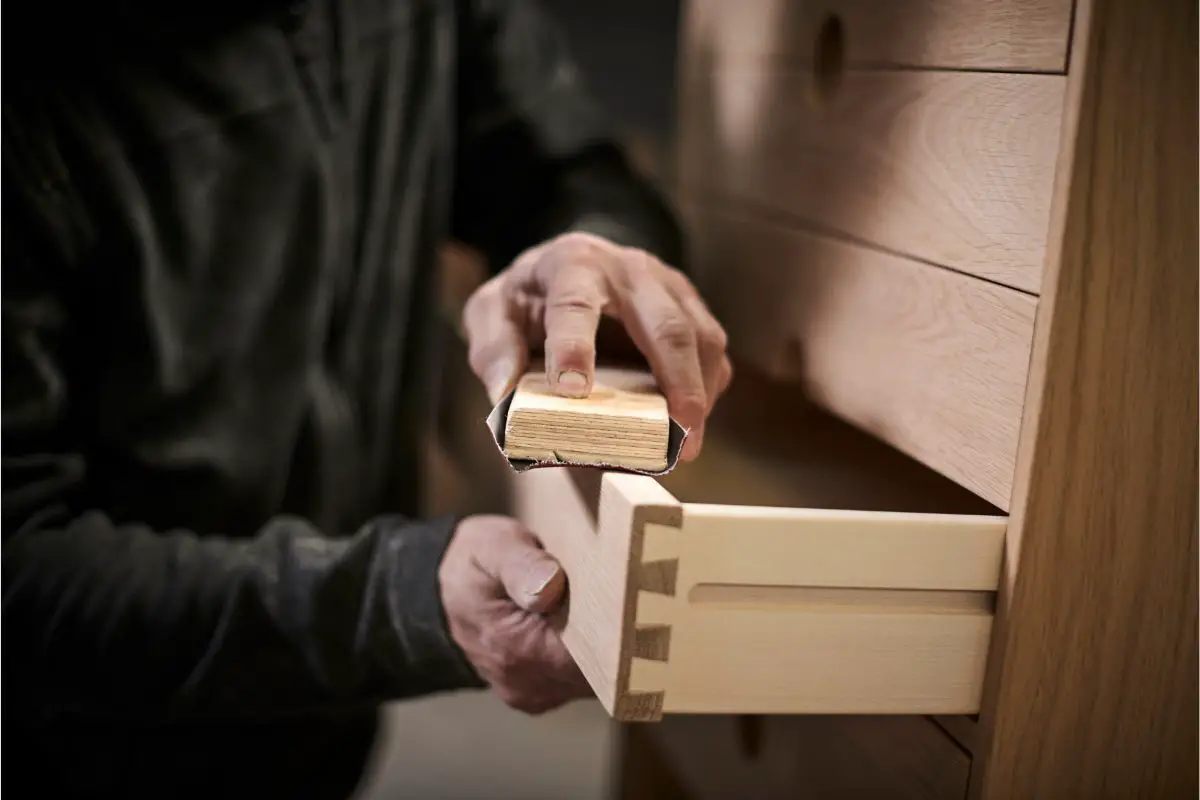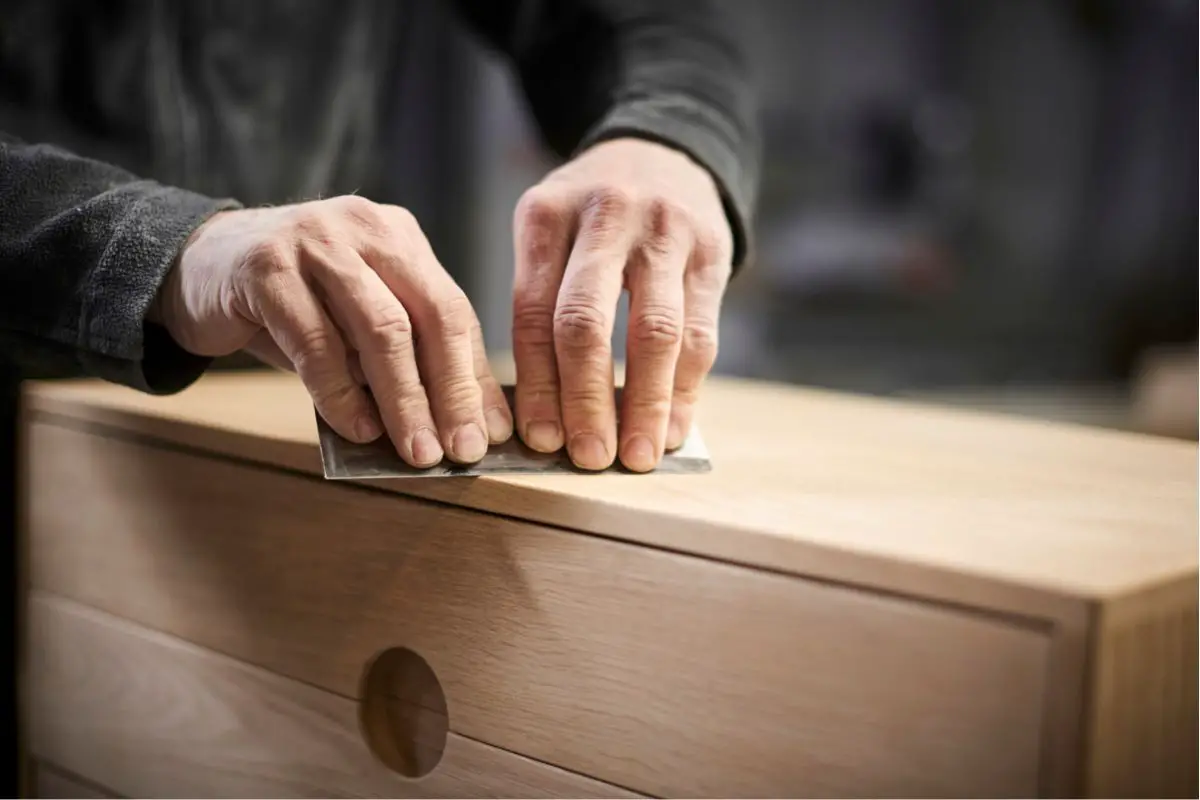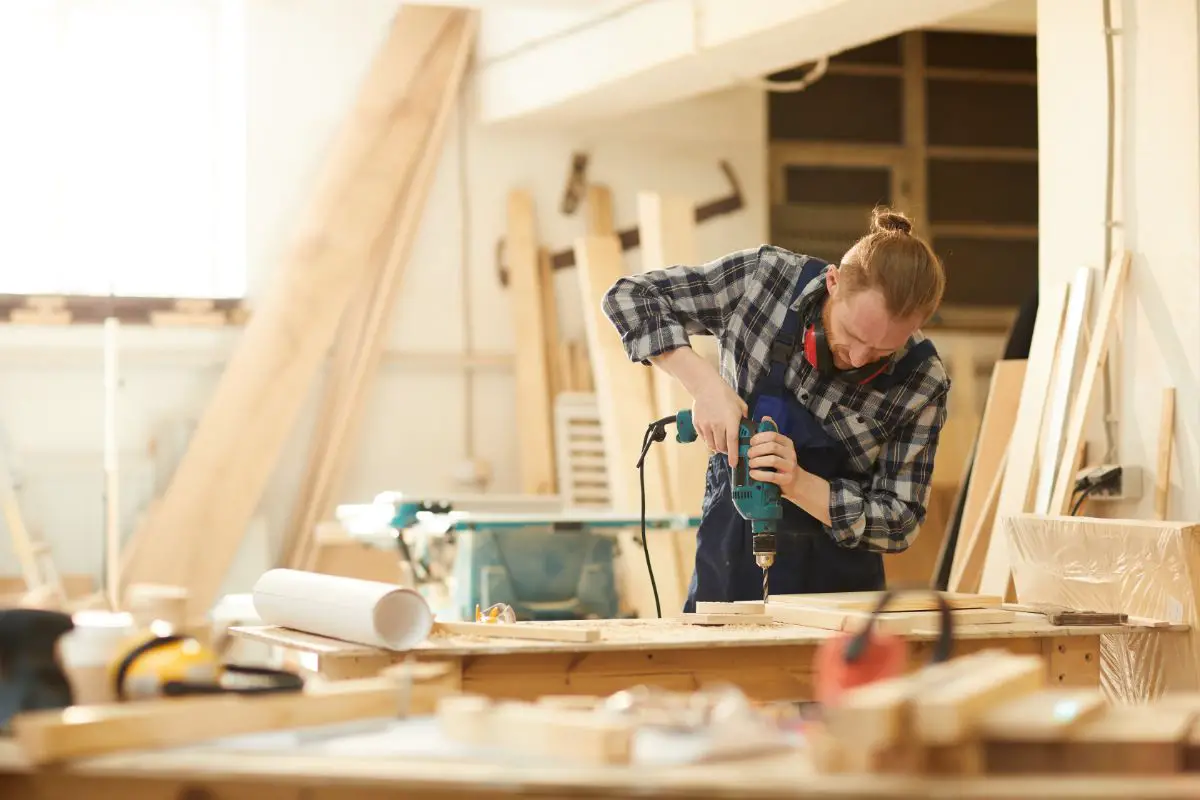Whether you’re creating a simple bookshelf, or a bespoke couch for your living room, it can be incredibly rewarding to build your own furniture – not to mention fun!

Still, it’s not fun all the time, and if you’re interested in building your own furniture you might be wondering if it’s worth the time and money, and having the time, money and resources will play a major role in your decision.
In this article, we’re going to take you through the pros and cons of building your own furniture, the essential tools you’ll need and how to get started.
But before we get into that, we just want to welcome visitors from handcraftstudio.com! At sergerpepper.com we’re all about helping people inject a bit more DIY into their lives, particularly when it comes to handmade clothes.
But in this article, we’re going to explore handmade furniture so you can take your DIY skills to the next level.
Is It Possible To Build Your Own Furniture?
Absolutely! It is definitely possible to build your own furniture, as it can be as simple and challenging as you would like.
You can just use a hammer, saw, and a couple of nails if you’d like, or you can go all out with a big set of professional tools.
The Advantages Of Making Your Own Furniture
Gives You A Chance To Learn New Skills
It’s undeniable that learning something new feels so good! Not only does it give you a chance to express yourself creatively, but problem-solving and working with your hands is an excellent workout for your brain.
The skills you acquire while building furniture are also transferable, and come in handy when making household repairs and fixing furniture you’ve bought from the store. Plus, learning new skills builds your confidence!
DIY Projects Make Awesome Gifts
It’s the thought that counts when it comes to gifts, and a lot of thought goes into handmade gifts! Not to mention time and love.
There is no better way to show someone you care about them than by making them a bespoke, handmade gift.
Even if you make a table or a birdhouse for a loved one, they’re sure to be extremely touched. Plus, learning how to create handmade furniture just expands your horizons when it comes to gift ideas.
DIY Furniture Can Be Kinder To Your Budget
If you have time to build your own furniture, it can save you a lot of money. Plus, the more experience you get, the fancier you can make a piece look even if you didn’t spend much money on it at all.
The Drawbacks Of Making Your Own Furniture
Of course, nothing worth having is ever totally easy, and there are a few obstacles to overcome when starting out on your handmade furniture journey. Let’s take a look at some potential obstacles.
Making Your Own Furniture Takes Time
The famous saying goes that Rome wasn’t built in a day, and your DIY furniture projects will take time too.
You need to plan your project, and then put the wheels in motion. Sometimes, the planning part of a project will take more time than the actual building of the furniture.
Most people tend to be impatient, and if you can relate to this then it can take some practice to be methodical and take things one step at a time.
If you rush, not only will you get frustrated and stressed out, but this can lead to a lesser quality product and could end up with you quitting entirely.
Building something will always be more time-consuming than buying something, so before you make a start on your project, you should think about if you have enough time to dedicate to a project.
Making Handmade Furniture Can Be Frustrating
When you create something by yourself, there are times when you’re going to be frustrated, especially if this is totally new to you. But even the most accomplished and experienced builders get frustrated, so you’re not alone.
Before you start making your own furniture, it’s good to be mentally prepared for the inevitable moments of frustration.
Pushing through these frustrations and overcoming these obstacles will be so satisfying, and you’ll have a beautifully finished product that you made with your own hands at the end of it all.

Overspending Materials And Tools Is All Too Easy
While making your own furniture can save you money, it is also very easy for budget to run away with you and you end up buying things you don’t actually need.
This is particularly true for beginners who might not be aware of what they need, and when overwhelmed will buy things that are unnecessary that can make the process more expensive.
However, good planning can help you avoid your budget falling apart. Before you start buying your tools, make a list of everything you need and plan out and draw a diagram of your project. If you’re ever unsure of what you need, these plans will guide you.
If you’re new to creating furniture, you need to balance your desire to create furniture with the equipment you already have.
As a beginner, you can probably afford to create something simple, but when you gain more experience and want to challenge yourself, you will need to invest more money and time into a project to achieve the desired result.
The Basics For Making Your Own Furniture
Now we’ll take you through how easy it is to make high-quality, professional-looking furniture on a budget and in relatively little time.
Learning The Basics Of Making DIY Furniture
You want to stand back and look at the finished product and be proud of it, and you want others to remark positively on your creation. Learning a few basics is a great way to ensure you’re happy with the end product.
For example, you can’t create a clean table if you don’t know how to make clean cuts, and you need to practice making precise measurements.
Similarly, there are techniques for how to correctly use a drill, and how to hammer a nail that you need to learn.
Before you make a start on your practice, practice these skills on some scrap boards.
Yes, you’re probably eager to start and practicing may feel boring, but the old saying ‘practice makes perfect’ is true for a reason! You’ll be happy you took the time to practice in the long run.
Start Simple
If you’re a beginner creating furniture, go easy on yourself. It’s important to keep in mind the inherent frustrations that come with building your own furniture, and pushing yourself can make the process only more frustrating.
When you’re planning your project, make sure the project aligns with your current skillset. In other words, start out simple.
When the project is complete you will have learned more skills and be so much more confident in your ability. Plus, in your next project you can go slightly bigger with your ambitions!
Plan Carefully
Plans may seem restrictive, but they can actually be very liberating. Planning can help you save time and money, and make the experience a lot more enjoyable.
If you’re new to making your own furniture, making a plan can make you better at building furniture, and watching tutorials, reading books, getting advice from a more experienced friend, and even taking courses or classes can be very beneficial, and online courses in particular can be super helpful.
Essential Tools For Making Homemade Furniture
Band Saw
A band saw is a powerful and beneficial tool, and is a saw tool with a single, vertical blade that you can use to make a wide range of cuts such as curves, cross-cuts, and miters.
Band saws come in a range of sizes and shapes, and so it’s best to choose one according to how much you intend to use it and how much space you have.
Smaller units are often perfect for woodworkers based at home, while professionals often use large cabinet versions.
It’s also worth considering the depth of the cut and throat so you know the band saw you choose can cut the depth and width of wood required for your project.
Belt Sander
If your wood is slightly rough around the edges (or rough all over) then a belt sander can help make it smoother in no time.
Some belt sanders rotate continuously to create a consistent sanding motion that is perfect for big projects.
However, they can be difficult when trying to navigate corners and more delicate parts of your project, so it’s also worth considering models that have features designed to navigate these tricky corners easier.
Another feature to keep in mind is a filtration system or dust collector which reduces how much sawdust you’ll have to deal with when you’re finished using it.
Belt sanders are powerful pieces of equipment and to be worth the money they need to be masterfully wielded. If you’ve never used a belt sander, you’ll have to be ready to learn the ropes.
Circular Saw
When working with wood, you normally begin with a range of pieces in a range of sizes, from large boards to plywood.
Creating handmade furniture involves shaping it – such as cutting it into smaller pieces or cutting it into a certain shape.
Circular saws are ideal for both cross-cuts that go across the wood grain, and rip cuts that go with the wood grain.
It’s also worth remembering that the blade is a crucial aspect of the tool. According to what kind of cut you’re marking, you should use a different blade.
These blades can assist with everything from the simplicity of the cut to decreasing vibration, and durability.
Although you can visit a hardware store to do the cutting, it makes sense to buy a versatile, powerful tool such as a circular saw.
Compound Miter Saw
You’ll require a saw to cut a variety of materials when making your own furniture, to give you some versatility in the kinds of cuts you’ll have to make.
A compound miter saw allows you to cut at an angle easily, and this is crucial in building wooden furniture. As well as moving the blade up and down, a compound miter saw can also tilt the blade to a variety of angles.

The size of the compound miter saw you need will depend on the project. The bigger the blade, the bigger the cut!
There are also compound miter saws that slide to help you save time moving boards. Rather, you simply adjust the saw to make the next cut.
Drill
A drill is a no-brainer no matter what type of furniture you’re making at home. A good old-fashioned drill that you can plug into the wall is a smart purchase, as it provides power that a cordless version can’t match.
Still, although cordless drills are not as powerful as corded ones, they’re still incredibly handy.
As well as giving you more flexibility when moving around your workspace, when making wooden furniture you’re often working with a range of boots.
Instead of frequently changing them, a cordless drill gives you the chance to effortlessly alternate between the two.
Impact Driver
An impact driver is like the superhuman version of a cordless drill! This is a convenient tool that was specifically designed for driving screws.
It uses rotation and concussive blows to power-drive screws into tough wood – making it ideal for creating handmade furniture!
The difference is immediately noticeable, since impact drivers normally deliver two or three times the turning force (i.e. the torque) of a standard driver.
Palm Router
Once the wood is cut up into the necessary pieces, you’ll have to think about the edges and other details.
This is where a palm router comes in handy, as they can help you take the legs of your furniture to the next level.
By routing out a section of wood with the tool, you can add extra intricate designs to the furniture. You can create stunning inlays and insets to make your project even more unique.
Plus, this handy little compact tool is only the size of your palm! The grooves and edges you can create with a palm router will instantly make you stand out and allow you to flex your creativity.
Pocket Hole Jig
Although drilling screws and holes is an important aspect of creating handmade furniture, there are times when drilling right into the surface just won’t do it.
For example, what if you would like to make more discreet screws? Well, you can enter the pocket hole jig. A pocket hole is one that is drilled into a board at an angle, concealing the end of the screw.
A pocket hole jig is a tool that seriously simplifies drilling these kinds of holes, and lets you connect two pieces of wood – for example, for the corner of a piece of wooden furniture.
The tool is fixed to your workstation and keeps pieces of wood upright. The jig can be adjusted according to the width of the piece of wood you’re using.
The holes in the jig are at an angle, and when the piece of wood is secured in the jig, it’s simple to drill through the jig to get the necessary pocket holes.
Portable Nailer
When creating your own furniture, a nail gun operated by batteries saves you energy and time. It’s like you’re going to be using these tools on your own, or with the assistance of others.
The speed offered by a portable nailer is invaluable when you’re trying to be more efficient with your time.
As well as being speedy, crooked or bent nails are no more when you have this tool at your disposal.
Plus, as the name suggests, you don’t need to plug a portable nailer into the wall, so you can walk around your workspace and easily navigate around the project you’re working on.
If you don’t have much experience with a nail gun, then a portable nailer might be intimidating. After all, it is a very powerful tool.
But if you take the time to look over the manual and familiarize yourself with the safety guidelines, then you should be good to go.
Right Angle Close Quarters Drill
When creating wood furniture, you’ll often need to drill in places where your drill just won’t fit.
When this happens, a right angle close quarters drill is essential. It’s a lot smaller and lightweight than standard drills, which let you navigate and drill in trickier spaces.
Even with corded models, the cord placement is placed strategically so it doesn’t get in the way of drilling.
Rip Cut Jig
A circular saw and a rip cut jig are a match made in heaven! It’s likely you will be cutting straight, precise lines during your project. In this case, a rip cut jig tool is essential.
Prop one end of the tool up against the edge of the piece of wood you’re cutting, and this end of the jig will lift the piece of wood as you cut.
Meanwhile, the other end of the jig will be placed over the piece of wood you’re cutting. This is where the circular saw comes in, guaranteeing straight cuts every time.
Final Thoughts
Building your own furniture can be time-consuming and frustrating, but is absolutely worth it.
We hope our article has given you all the tools you need to embark on your very first project, but the biggest piece of advice we can give you is to make a plan and stick with it, as this will help you save money and time.
If you would like to make your own furniture, start out small and then work your way up to more challenging projects.
While we may recoil at the thought of failure, it is essential to learning, and building your own furniture is no exception.
